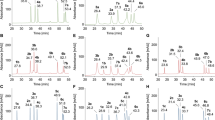Abstract
Stereoinversion of Ser residues within proteins, which has been identified in long-lived proteins, influences protein function. To quantify the stereoinversion of Ser residues, we investigated the potential adaptation of our direct peptide analytical method originally established for analyzing the isomerization of asparaginyl/aspartyl residues. Peptide pairs containing l-Ser or d-Ser residues with lengths of four or five residues were synthesized. Separation conditions for these peptide pairs were systematically examined by precisely adjusting the pH of the elution solvent using reverse-phase high-performance liquid chromatography (HPLC). Optimal separation conditions were successfully developed for all peptide pairs, enabling the direct quantification of Ser residue stereoinversion through a single HPLC run. Subsequently, the degree of Ser stereoinversion within the model peptide, Gly-Ser-Gly-Tyr, was determined using the method established in this study. Surprisingly, the stereoinversion of Ser residues occurred only when the absolute configurations of Ser and Tyr residues of the peptide differed from each other, whereas no stereoinversion was observed when their absolute configurations were identical. The experiments using peptides similar to the model peptide reveal that both the N-terminal amino group and the hydroxyl group of the C-terminal Tyr residue are involved in the stereoinversion of the Ser residue. By applying a simple method to quantify the stereoinversion of Ser residues, valuable insights into the mechanisms governing these stereoinversions were obtained.
Graphical abstract








Similar content being viewed by others
Data availability
Data are available from the corresponding author upon reasonable request.
References
T. Geiger, S. Clarke, J. Biol. Chem. 262, 785–794 (1987). https://doi.org/10.1016/S0021-9258(19)75855-4
Y. Sadakane, M. Kawahara, Int. J. Mol. Sci. 19, E2449 (2018). https://doi.org/10.3390/ijms19082449
F. Curnis, R. Longhi, L. Crippa, A. Cattaneo, E. Dondossola, A. Bachi, A. Corti, J. Biol. Chem. 281, 36466–36476 (2006). https://doi.org/10.1074/jbc.M604812200
A. Corti, F.J. Curnis, J. Cell Sci. 124, 515–522 (2011). https://doi.org/10.1242/jcs.077172
Y. Sadakane, T. Yamazaki, K. Nakagomi, T. Akizawa, N. Fujii, T. Tanimura, M. Kaneda, Y. Hatanaka, J. Pharm. Biomed. Anal. 30, 1825–1833 (2003). https://doi.org/10.1016/s0731-7085(02)00525-3
Y. Sadakane, K. Konoha, M. Kawahara, K. Nakagomi, Chem. Biodivers. 7, 1371–1379 (2010). https://doi.org/10.1002/cbdv.200900330
N. Fujii, H. Sakaue, H. Sasaki, N. Fujii, J. Biol. Chem. 287, 39992–40002 (2012). https://doi.org/10.1074/jbc.M112.399972
R. Shapira, C.H. Chou, Biochem. Biophys. Res. Commun. 146, 1342–1349 (1987). https://doi.org/10.1016/0006-291X(87)90797-2
M.Y.S. Hooi, R.J.W. Truscott, Age 33, 131–141 (2011). https://doi.org/10.1007/s11357-010-9171-7
T.V. Stabler, S.S. Byers, R.D. Zura, V.B. Kraus, Arthritis Res. Ther. 11, 34–42 (2009). https://doi.org/10.1186/ar2639
M.Y. Hooi, M.J. Raftery, R.J. Truscott, Protein Sci. 22, 93–100 (2012). https://doi.org/10.1002/pro.2191
Y.A. Lyon, M.P. Collier, D.L. Riggs, M.T. Degiacomi, J.L. Benesch, R.R. Julian, J. Biol. Chem. 294, 7546–7555 (2019). https://doi.org/10.1074/jbc.ra118.007052
R. Shapira, G.E. Austin, S.S. Mirra, J. Neurochem. 50, 69–74 (1988). https://doi.org/10.1111/j.1471-4159.1988.tb13231.x
T. Kubo, Y. Kumagae, C.A. Miller, I. Kaneko, J. Neuropathol. Exp. Neurol. 62, 248–259 (2003). https://doi.org/10.1093/jnen/62.3.248
T. Kubo, S. Nishimura, Y. Kumagae, I. Kaneko, J. Neurosci. Res. 70, 474–483 (2002). https://doi.org/10.1002/jnr.10391
M. Yamasaki, N. Takahashi, M. Hirose, J. Biol. Chem. 278, 35524–35530 (2003). https://doi.org/10.1074/jbc.M305926200
N. Takahashi, M. Onda, K. Hayashi, M. Yamasaki, T. Mita, M. Hirose, Biosci. Biotechnol. Biochem. 69, 922–931 (2005). https://doi.org/10.1271/bbb.69.922
T. Miyamoto, M. Sekine, T. Ogawa, M. Hidaka, H. Homma, H. Masaki, Amino Acids 38, 1377–1385 (2010). https://doi.org/10.1007/s00726-009-0348-2
J.L. Bada, J. Am. Chem. Soc. 94, 1371–1373 (1972). https://doi.org/10.1021/ja00759a064
G.G. Smith, G.V. Reddy, J. Org. Chem. 54, 4529–4535 (1989). https://doi.org/10.1021/jo00280a017
Y. Sadakane, N. Fujii, K. Nakagomi, J. Chromatogr. B 879, 3240–3246 (2011). https://doi.org/10.1016/j.jchromb.2011.03.020
B. Lyons, A.H. Kwan, J. Jamie, R.J. Truscott, FEBS J. 280, 1980–1990 (2013). https://doi.org/10.1111/febs.12217
P. Santhoshkumar, P. Udupa, R. Murugesan, K.K. Sharma, J. Biol. Chem. 283, 8477–8485 (2008). https://doi.org/10.1074/jbc.M705876200
B. Lyons, J. Jamie, R.J. Truscott, Int. J. Pept. Res. Ther. 17, 131–135 (2011). https://doi.org/10.1007/s10989-011-9250-3
B. Lyons, A.H. Kwan, R.J. Truscott, Aging Cell 15, 237–244 (2016). https://doi.org/10.1111/acel.12428
B. Lyons, J.F. Jamie, R.J. Truscott, Amino Acids 46, 199–207 (2014). https://doi.org/10.1007/s00726-013-1619-5
S.M. Steinberg, J.L. Bada, J. Org. Chem. 48, 2295–2298 (1983). https://doi.org/10.1021/jo00161a036
R. Liardon, S. Ledermann, J. Agric. Food Chem. 34, 557–565 (1986). https://doi.org/10.1021/jf00069a047
Funding
This work was partially supported by JSPS KAKENHI (Grant number 19K07031 and 23K06088). The authors acknowledge the support, but JSPS KAKENHI had no role in the design of the study, data collection, analysis, interpretation of results, or writing of the manuscript.
Author information
Authors and Affiliations
Corresponding author
Rights and permissions
Springer Nature or its licensor (e.g. a society or other partner) holds exclusive rights to this article under a publishing agreement with the author(s) or other rightsholder(s); author self-archiving of the accepted manuscript version of this article is solely governed by the terms of such publishing agreement and applicable law.
About this article
Cite this article
Sadakane, Y., Kobayashi, M., Sano, M. et al. Quantification of serine residue stereoinversion in a short peptide by reversed-phase high-performance liquid chromatography: analysis of mechanisms promoting serine stereoinversion. ANAL. SCI. 40, 925–934 (2024). https://doi.org/10.1007/s44211-024-00543-5
Received:
Accepted:
Published:
Issue Date:
DOI: https://doi.org/10.1007/s44211-024-00543-5



